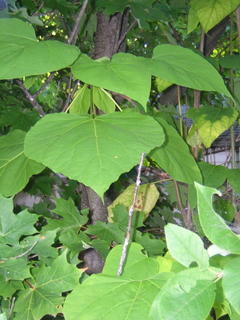Indian-bean
 This northern catalpa (Catalpa speciosa) tree has sprouted in amongst a thicket of wild cherries and Norway maples. Its leaves come latest in the season. There is another catalpa of the same species, perhaps even a relative, on the other corner of the property next to mine. It is growing on the west side of an enormous white oak. This one hasn't matured and hasn't flowered, but it has grown for several years now, reaching out from underneath the cherry towering to its east. Every leaf it makes it makes to face the open air of the right-of-way and potential sunlight. The maples in its vicinity have all got brown rotted splotches covering their leaves, some sort of fungus, I suppose, but the catalpa appears fungus-free. It isn't a native to the north. This large-leaved showy, flowering tree was named by the native Americans. Catalpa are a tropical tree, who once had the luxury of growing large leaves, for certainty of sunshine. Now it conserves its energy, coming in late, leaving early and waiting years to flower. It will be back next year. Of this I am certain.
This northern catalpa (Catalpa speciosa) tree has sprouted in amongst a thicket of wild cherries and Norway maples. Its leaves come latest in the season. There is another catalpa of the same species, perhaps even a relative, on the other corner of the property next to mine. It is growing on the west side of an enormous white oak. This one hasn't matured and hasn't flowered, but it has grown for several years now, reaching out from underneath the cherry towering to its east. Every leaf it makes it makes to face the open air of the right-of-way and potential sunlight. The maples in its vicinity have all got brown rotted splotches covering their leaves, some sort of fungus, I suppose, but the catalpa appears fungus-free. It isn't a native to the north. This large-leaved showy, flowering tree was named by the native Americans. Catalpa are a tropical tree, who once had the luxury of growing large leaves, for certainty of sunshine. Now it conserves its energy, coming in late, leaving early and waiting years to flower. It will be back next year. Of this I am certain.As if his own incompetence were a virtue. It is refreshing, however, to see the nobility of the American people, when pressed. This was not the way Exodusters fleeing Kansas were treated in the Depression, nor is it anything like the unwelcoming that met the Great Migration of sharecroppers in Chicago during the teens. It is a genuine helping hand, it seems, real empathy. Being a cynic, I wonder two things. How long will it last? and Why does it take a disaster to bring it out in us?

0 Comments:
Post a Comment
<< Home